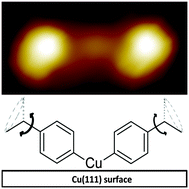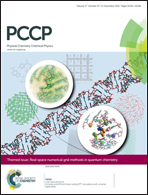Ullmann coupling mediated assembly of an electrically driven altitudinal molecular rotor†
Abstract
Surface-bound molecular rotation can occur with the rotational axis either perpendicular (azimuthal) or parallel (altitudinal) to the surface. The majority of molecular rotor studies involve azimuthal rotors, whereas very few altitudinal rotors have been reported. In this work, altitudinal rotors are formed by means of coupling aryl halides through a surface-mediated Ullmann coupling reaction, producing a reaction state-dependent altitudinal molecular rotor/stator. All steps in the reaction on a Cu(111) surface are visualized by low-temperature scanning tunneling microscopy. The intermediate stage of the coupling reaction is a metal–organic complex consisting of two aryl groups attached to a single copper atom with the aryl rings angled away from the surface. This conformation leads to nearly unhindered rotational motion of ethyl groups at the para positions of the aryl rings. Rotational events of the ethyl group are both induced and quantified by electron tunneling current versus time measurements and are only observed for the intermediate structure of the Ullmann coupling reaction, not the starting material or finished product in which the ethyl groups are static. We perform an extensive set of inelastic electron tunneling driven rotation experiments that reveal that torsional motion around the ethyl group is stimulated by tunneling electrons in a one-electron process with an excitation energy threshold of 45 meV. This chemically tunable system offers an ideal platform for examining many fundamental aspects of the dynamics of chemically tunable molecular rotor and motors.


 Please wait while we load your content...
Please wait while we load your content...